Vintage Trade (古飾洋行) owner Tiffany Chen (陳怡安) has lost count of how many pieces of antique and vintage jewelry she has collected since she was a teenager, but says it is “more than a few thousand.” In 2008, she decided to turn her hobby into a business.
Unsure of how customers in Taiwan would react to vintage items from the US, where she grew up, Chen started small, selling jewelry out of a suitcase in Shida night market on days off from her job as a freelance simultaneous interpreter. Within a year, she was confident enough to open a brick-and-mortar store. Vintage Trade’s cozy, window-lined space is located near the corner of Civic Boulevard and Fuxing South Road in Taipei.
“Everyone who walks in here has a connection to certain pieces. A lot of customers tend to gravitate to the 1950s, 60s or the 80s, it depends on their style and taste and personality,” Chen says. “Some people have an old soul, they go for the 1920s and 30s. If they like art, they go for art nouveau or art deco items.”
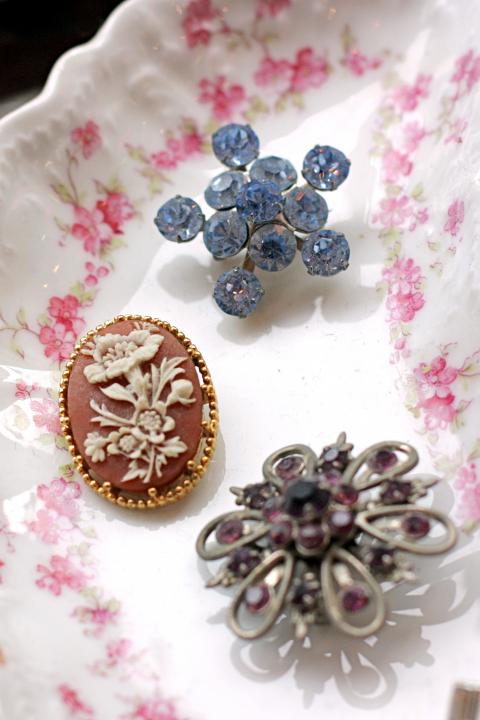
Photo: Catherine Shu, Taipei Times
Vintage Trade’s shelves are lined with hundreds of pieces of jewelry, organized by style and era. Rhinestone screw back earrings made in the 1940s and aurora borealis crystal necklaces from the 1950s sparkle in the sunlight. Necklaces by Trifari, Coro or Sarah Coventry, American brands popular among collectors, are displayed near vintage magazine ads. The oldest items in the store include a brooch and gold rings set with sapphires and diamonds from the 1910s.
Vintage Trade also carries other accessories like purses and scarves, along with home items such as Vaseline glass figurines and children’s portable record players. Chen’s interpretation work (her specialties are antitrust cases and press conferences) is still the main source of her personal income, which she says allows her to charge reasonable prices despite the tiny market for vintage costume jewelry in Taiwan. Prices range from NT$200 to about NT$20,000 for rarer pieces, with most jewelry selling for NT$1,000 to NT$3,000.
Chen treats Vintage Trade like a second home. Bonsai plants she cultivated from clippings are placed near windows, a shelf is filled with guides about vintage collectibles and her dog, a female Shiba Inu named Dou Dou, runs to the door to greet customers.
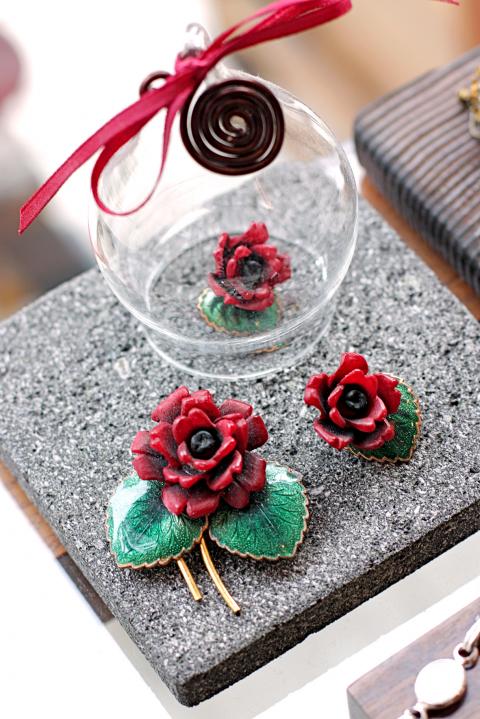
Photo: Catherine Shu, Taipei Times
Shoppers who linger for a while are invited to pull up a chair and look at items from Chen’s personal collection of Ming and Qing dynasty sterling silver rings, or try on stacks of Bakelite bangles that she is still trying to figure out how to market. (Chen says that many Taiwanese view Bakelite jewelry, highly sought-after collectibles in the US and the UK, as just old plastic.)
Chen moved to southern California with her parents when she was 9 years old. Her first vintage jewelry purchase was a pair of faux pearl Avon earrings made in the 1970s that she found in an antique store near her family’s home in San Pedro, California.
“They were studs with gold-plated rings around them,” Chen says. “I loved them. I still keep some of my earlier pieces, because to me they hold special meaning.”
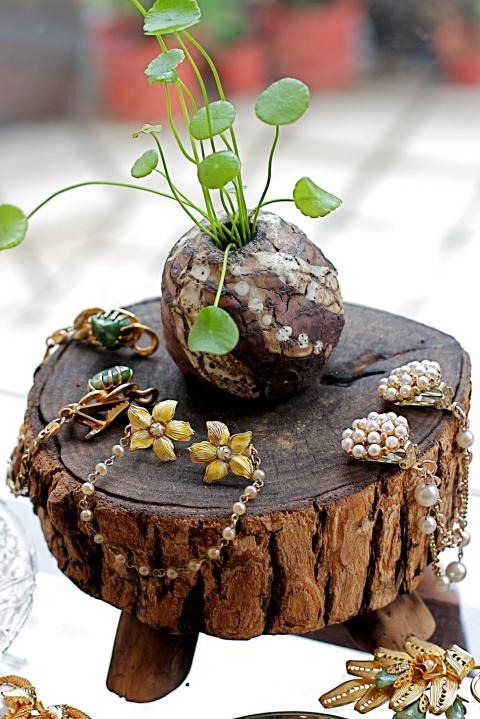
Photo: Catherine Shu, Taipei Times
She returned to Taiwan to study for a master’s degree in translation and interpretation at Fujen Catholic University (輔仁大學). After graduating, she stayed in Taipei City and began working as a freelance conference interpreter. On her days off, Chen went hunting for vintage jewelry, but was disappointed by the selection in stores here.
“If you have been collecting for a while, you know what they have is not vintage jewelry, it’s stuff imported from Thailand or found in flea markets that is not worth anything,” Chen says.
Sensing a potential market niche, she decided to sell some of the pieces she had accumulated since she was a teenager. She started in Shida night market on weekends because a friend owned a clothing store there.
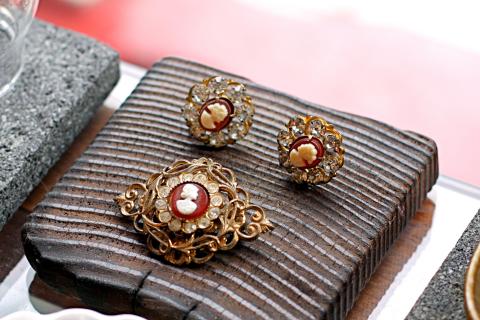
Photo: Catherine Shu, Taipei Times
“My plan was to go to the night market for at least one year. I would stay there no matter what for at least one year and, if everything went well, I would look for a space and open a store,” she says.
On some weekends Chen made only a couple thousand NT dollars, but on others, she would earn between NT$20,000 to NT$30,000 (most of her items were priced under NT$500). After six months, she had developed a base of regular customers and was grossing an average of NT$100,000 a month, enough to convince her to rent a storefront.
She returns to the US once or twice a year, but mostly relies on her mother to pick up and ship pieces from the network of vintage and antique dealers Chen cultivated while living in southern California.
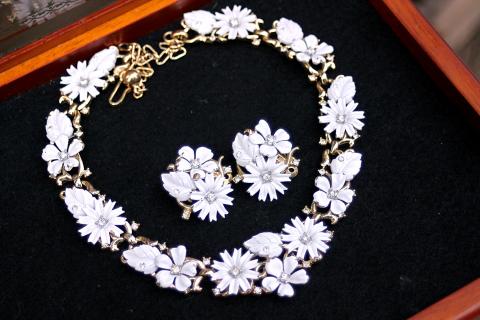
Photo: Catherine Shu, Taipei Times
“People don’t realize the kind of inventory that I have. They think it’s all for business, but the fun of it is that I love [vintage jewelry] so much,” Chen says.
“To other people, the jewelry [pieces] are dollar signs, but to me they are my babies,” adds Chen, who recently hired her first part-time employee and is now organizing and inventorying her massive stock.
“It’s such a big job, but the store is not that difficult to operate. I treat it like my living room,” Chen says. “Friends come in and chat with me, people come in and look at stuff. If I make a sale, I do, but if I don’t, it’s okay.”
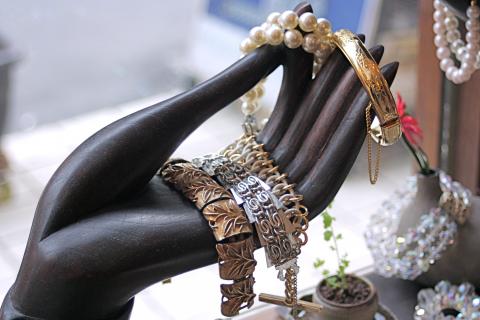
Photo: Catherine Shu, Taipei Time
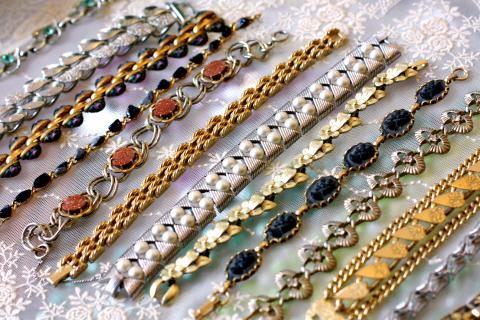
Photo: Catherine Shu, Taipei Times
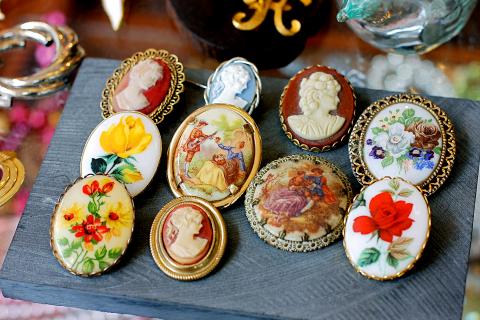
Photo: Catherine Shu, Taipei Times

Photo: Catherine Shu, Taipei Times
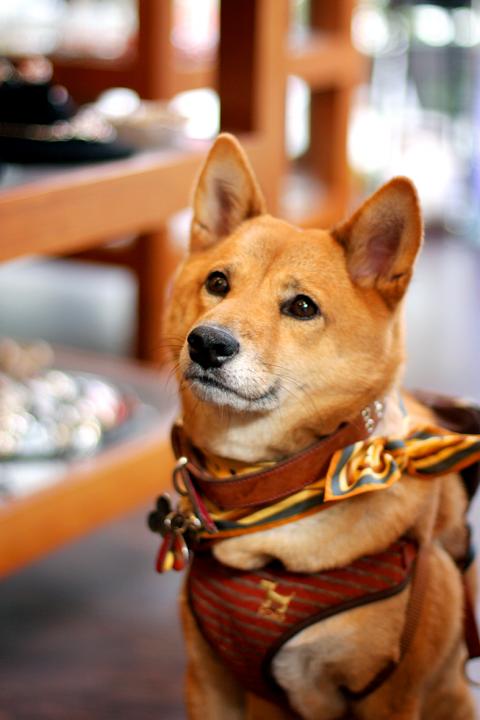
Photo: Catherine Shu, Taipei Times

May 26 to June 1 When the Qing Dynasty first took control over many parts of Taiwan in 1684, it roughly continued the Kingdom of Tungning’s administrative borders (see below), setting up one prefecture and three counties. The actual area of control covered today’s Chiayi, Tainan and Kaohsiung. The administrative center was in Taiwan Prefecture, in today’s Tainan. But as Han settlement expanded and due to rebellions and other international incidents, the administrative units became more complex. By the time Taiwan became a province of the Qing in 1887, there were three prefectures, eleven counties, three subprefectures and one directly-administered prefecture, with

It’s an enormous dome of colorful glass, something between the Sistine Chapel and a Marc Chagall fresco. And yet, it’s just a subway station. Formosa Boulevard is the heart of Kaohsiung’s mass transit system. In metro terms, it’s modest: the only transfer station in a network with just two lines. But it’s a landmark nonetheless: a civic space that serves as much more than a point of transit. On a hot Sunday, the corridors and vast halls are filled with a market selling everything from second-hand clothes to toys and house decorations. It’s just one of the many events the station hosts,

Among Thailand’s Chinese Nationalist Party (KMT) villages, a certain rivalry exists between Arunothai, the largest of these villages, and Mae Salong, which is currently the most prosperous. Historically, the rivalry stems from a split in KMT military factions in the early 1960s, which divided command and opium territories after Chiang Kai-shek (蔣介石) cut off open support in 1961 due to international pressure (see part two, “The KMT opium lords of the Golden Triangle,” on May 20). But today this rivalry manifests as a different kind of split, with Arunothai leading a pro-China faction and Mae Salong staunchly aligned to Taiwan.

Two moves show Taichung Mayor Lu Shiow-yen (盧秀燕) is gunning for Chinese Nationalist Party (KMT) party chair and the 2028 presidential election. Technically, these are not yet “officially” official, but by the rules of Taiwan politics, she is now on the dance floor. Earlier this month Lu confirmed in an interview in Japan’s Nikkei that she was considering running for KMT chair. This is not new news, but according to reports from her camp she previously was still considering the case for and against running. By choosing a respected, international news outlet, she declared it to the world. While the outside world